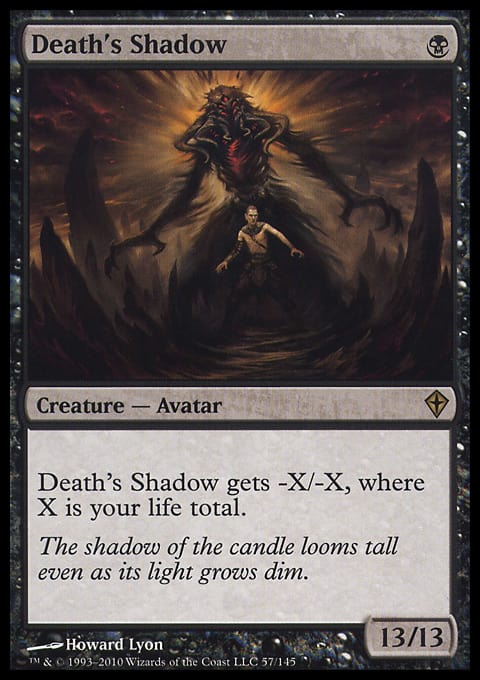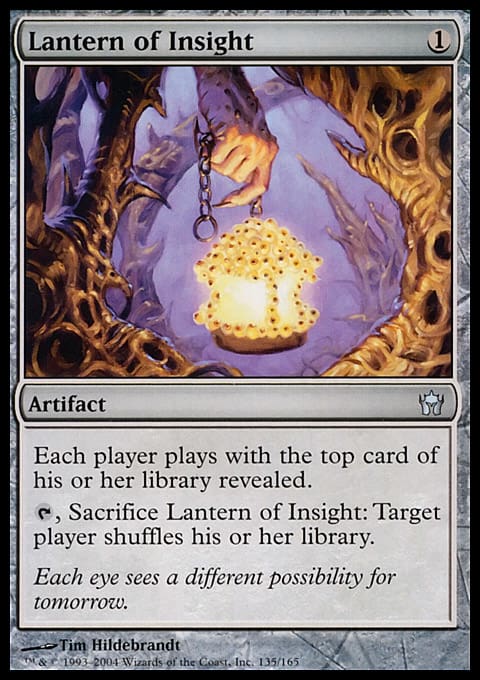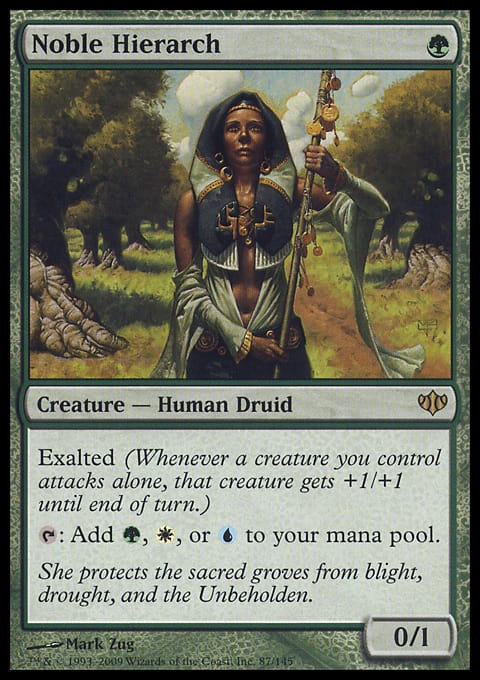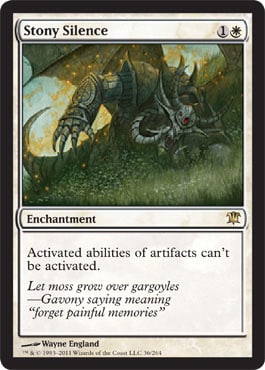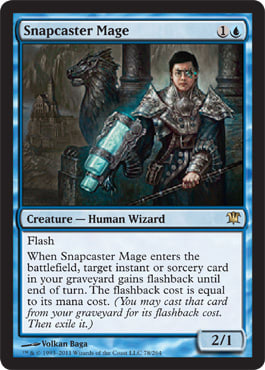Look, I get it. You’re excited to bash Smuggler's Copters against each other for the next year and a half. Maybe dueling Ishkanahs are more your speed, or figuring out how crappy Wizards can make a Rune Snag before it’s actually unplayable. (I knew Rune Snag. I loved Rune Snag. Revolutionary Rebuff is no Rune Snag!) Maybe you’re going to go off the beaten path and play some Madness deck, where if you try really hard, you can squint and pretend your Fiery Temper is a Lightning Bolt.
Standard? Bleh. Standard is the O’Doul’s of Magic. It’s mayo and American cheese on white bread. It’s a garden salad at a mediocre chain restaurant. Give me something with a little more kick, you know? A format where we loosen the restraints a little bit. A format with turn-3 kills, where you have to sign a waiver to play. (Wait, that’s most tournaments. Forget I said that. But you get the picture.)
It’s no secret that Modern is a fairly broken format. Dredge, Infect, Burn, Affinity, and Death's Shadow set the pace for a landscape where, if you’re not careful, you’ll get your head chopped off before you even set up. Then, even if you do interact with your opponent, there’s often a second or even third wave before they lay down and admit defeat. Be warned, because Blood Moons lurk around every corner, and you might just get hit with a Lightning Storm or a turn-two Griselbrand if you aren’t prepared to interact on that axis. Oh yeah, and Lantern. Ugh, Lantern.
Aside: Lantern came along and horned in on Modern like Neo-Cubism swept up early 20th century European art. The deck, like any of Picasso’s masterpieces, is beautiful in an unexpected, unassuming, somewhat ugly way. It truly is a work of art, and even though Lantern makes Modern miserable if it ever breaks ten percent of the metagame, it’s the kind of deck that only comes along once in a lifetime, if that. I’m not being melodramatic here. If and when Lantern Prison gets banned (make no mistake, banning Ensnaring Bridge would cleanly end the deck), you will never see another deck that tries to win on the same axis in competitive play ever again. There has never been a deck before that locks the opponent not on lands (Stax, Blood Moon), nor on untap steps (Stasis), nor on castable spells (Chalice of the Void), but on relevance of their draws. We may never again see such a perfect confluence of unplayable last-pick draft chaff with powerful mana acceleration and card selection in Mox Opal and Ancient Stirrings as well as a single-card lockout against aggressive strategies in Bridge. I thereby strongly urge each and every one of you to at least explore the deck, because there is an “edge” of Magic, where the fundamental tenets of the game start to break down, and Lantern is probably the closest we will ever get to the abyss.
Some of you may say that I’m wrong, that the Dredge mechanic and associated unfun games where one player wins without casting a single spell are the furthest away from Richard Garfield’s original vision. Some may point to the Storm mechanic, or decks like High Tide. I respectfully disagree, because those decks all involve winning via attacking creatures or casting a flurry of spells culminating in a powerful finishing move. Lantern wins without doing anything remarkable. It just sits there once it’s assembled the lock, stoically and methodically ensuring that you cannot possibly win over a dozen or more mind-numbing, frustrating turns. I’ve quoted George Orwell before in my writing, but a Lantern lock truly is Magic’s equivalent of Big Brother. “If you want a picture of the future, imagine a [Codex Shredder] stamping on a human face — forever.”
. . .
Well, that was a refreshing digression! Now, aside from potential existential crises when you face some of Modern’s more interesting and unusual decks, it’s certainly a fast-paced, exciting format, and (contrary to popular bellyaching) rewards skill and experience handsomely. But recently, something wonderful has happened. Magic’s Organized Play department decided to up the ante and offer us a combination of the thrills of Modern with the camaraderie of Team Limited, resulting in possibly the most exciting tournament of 2017 in Grand Prix San Antonio. I mean, it just makes sense, when you think about it. If and when you are under the “enhanced interrogation techniques” of a Lantern lock, you might as well have a buddy sitting on your left who can talk you off your impending tilt.
Now, this isn’t quite regular Modern, but rather “Team Unified Modern”, which means that no decks on the three-person team can have any copies of the same cards other than basic lands. That means that you can kiss your dreams of an Infect/Affinity dream team goodbye, and no, you can’t all play Burn. But restrictions breed creativity, and Modern is a big format. It’s big enough to encompass decks from Affinity to Zoo, so it’s big enough for you. It’s so varied, in fact, that the permutations and combinations of archetypes are fairly imposing and intimidating. To that end, I’d like to prepare us well in advance by proposing a few basic tenets that we can take as the basic, level-zero strategy for how to structure your team. If you’re lucky enough to be playing in the World Magic Cup in a few weeks, hopefully you can make use of these guidelines just the same.
Let’s start with the elephant(s) in the room. You’re probably going to want to use the most powerful creature-land (and maybe the most powerful land, although Eldrazi Temple has a lot to say about that) in the format, and you have two options for that in Infect or Affinity. If you do that, you will also probably want to use the most powerful single card in the format in Mox Opal. You can do that with Affinity or Lantern. If you choose to go with Affinity and forgo Lantern and Infect, you’ll want something to do with that Noble Hierarch and that Ancient Stirrings, as those are two of the best cards in the format. What deck uses Hierarch and Ancient Stirrings? Bant Eldrazi. Looks like a love square, where you have incompatibility between Infect and Affinity, Infect and Bant Eldrazi, and Affinity and Lantern. This, then, is basic level-zero strategy, where you can lock in Infect+Lantern or Affinity+Bant Eldrazi.
Two-thirds of your team locked? That’s awesome! These two combinations are going to be anchors of a good number of teams, backed up by a Lightning Bolt or Dredge deck in the third seat.
But what should that third deck be? If you’re playing Affinity and Bant Eldrazi, you may want to consider Death's Shadow as your Bolt deck, as that deck also uses the most powerful Delve and Phyrexian Mana spells in Gitaxian Probe and Become Immense. Affinity, Bant Eldrazi, and Death's Shadow . . . terrifying. If you’re using Infect and Lantern, you’ll probably want to play Burn or Bushwhacker Zoo as your third deck (should you choose to employ Lightning Bolt), both because Burn and Bushwhacker Zoo eschew Infect’s Gitaxian Probe and Become Immense, and because Burn/Bushwhacker Zoo has favorable matchups against a lot of the common aforementioned archetypes. Burn is strong against Infect, Death's Shadow, and Lantern, with a close matchup against Affinity. It’s a slight dog to Bant Eldrazi in general, and Dredge is . . . well, it’s Dredge, but you can fix that matchup with a healthy dose of sideboard hate.
So, as it currently stands, examining just seven of the most powerful archetypes in Modern, the best three-deck configurations are (in no particular order):
- Affinity-Bant Eldrazi-Death's Shadow
- Affinity-Bant Eldrazi-Burn/Bushwhacker Zoo
- Affinity-Bant Eldrazi-Dredge
- Affinity-Death's Shadow-Dredge
- Bant Eldrazi-Death's Shadow-Dredge
- Bant Eldrazi-Burn/Bushwhacker Zoo-Dredge
- Infect-Lantern-Burn/Bushwhacker Zoo
- Infect-Lantern-Dredge
- Infect-Dredge-Burn/Bushwhacker Zoo
- Lantern-Dredge-Burn/Bushwhacker Zoo
I can confidently say that you have a very good chance of facing some of these exact three-deck configurations when you attend the Grand Prix, and it gets even more ubiquitous if you look at configurations that include two of these decks and a rogue third deck. In fact, I’d go so far as to guess that two-of-these-plus-a-rogue-deck configurations will comprise fully half of your team’s matches, because at least one member of most teams will be drawn to these powerful, Tier 1 archetypes.
Well, that about wraps it up, right? Just play one of these and prepare for loads of mirror matches, right? Not so fast. We have to address the fact that you’re likely to encounter a disproportionate amount of Dredge, because there are only a few excellent options for sideboard hate and almost no way to fit more than four strong hate cards in each sideboard. When people can maindeck Anger of the Gods and sideboard Surgical Extraction, you would be well-served by not Dredging. When the hate has to be carefully balanced across three decks, things get trickier. The same is true for Affinity, when only one out of three opponents can pack Stony Silence, Ancient Grudge, Shatterstorm, or Creeping Corrosion.
We can say with confidence that linear decks (or more precisely, hyper-powerful decks that only lose to specific hate cards) get better in a format where you must judiciously split up your sideboard answers. A one-in-three chance of facing Stony Silence in post-sideboard games each round? Sounds like an Affinity player’s dream, no? If I were an Affinity player, I’d be rubbing my hands with glee at the prospect of such a clear metagame with Infect and Dredge as my big sideboard targets. Grafdigger's Cages, Spellskites, and Gut Shots, here we come!
But you see, this is where the metagame levels start to come into play. If you expect a metagame like this, decks with rough matchups against the hyper-linears are very bad choices. I’m talking Tron, Ad Nauseam, Bogles, even Blood Moon decks seem poorly positioned if the opponent is playing Dredge or Affinity half the time. How can we target these decks, to maybe get an edge with a rogue third option? Well, whatever happened to Jund and Jeskai Nahiri? Jeskai Nahiri mauls Infect, Burn, and Affinity, right? It can certainly be structured to do so, at least. A pile of Anger of the Gods and Rest in Peaces for Dredge, some Timely Reinforcements to shore up the Burn matchup, some Stony Silences for Affinity and Lantern, and things start to look . . . well, pretty good, actually. Control gets better the more predictable the metagame is, and when you have over a fifty percent chance of playing against one of the archetypes you targeted, you start to have a pretty attractive option for your “Lightning Bolt archetype”. Maindeck Path to Exile, Lightning Bolt, Snapcaster Mage is almost always going to put you ahead of whatever Inkmoth Nexus archetype your opponent chooses, and Jeskai Nahiri is ahead against all of the other Lightning Bolt decks out there, so let’s try to factor it into our metagame map as well:
- Jeskai-Infect-Lantern
- Jeskai-Dredge-Lantern
- Jeskai-Dredge-Infect
- Jeskai-Dredge-Affinity
(Note: Jeskai precludes Bant Eldrazi, Death's Shadow, and Burn/Zoo because of overlaps with Bolt and Path)
The nice thing about the Jeskai-Dredge cluster is that Dredge can play Leyline of the Void for the mirror match, leaving tons of good hate like Rest in Peace and Grafdigger's Cage available for the Jeskai and Infect decks. Lantern, oddly enough, is close against Dredge, but Sam Black likes his side of the matchup. Having maindeck Surgical Extraction and access to more in the sideboard certainly doesn’t hurt! Additionally, if as many teams field a Lantern player as I suspect they will, Surgical Extraction is a key element of the mirror match.
In Jeskai-Infect-Lantern, Jeskai-Dredge-Lantern, and Jeskai-Infect-Dredge, we see decks that are all capable of beating Affinity on their own merits, with one slightly rogue archetype as a hopeful target for the Level Zero metagame. If I were to play Dredge, I’d want a full complement of Leyline of the Void, as well as a pile of Ancient Grudges and Natural States. (Save the Nature's Claims for the Infect deck, please!)
Let’s wrap it all together in a TL;DR for a very premature look at the Team Unified Modern metagame:
You are going to see less diversity, in my opinion, because almost every team will want one or two unfair-ish decks on their roster. The powerhouse cards of Mox Opal, Ancient Stirrings, Noble Hierarch, Become Immense, Gitaxian Probe, Lightning Bolt, Inkmoth Nexus, and the entire Dredge mechanic are going to be present in basically every three-on-three matchup in some capacity. I believe that you can prepare for this heavy influx of certain linears by building a control deck, specifically Jeskai Nahiri control, as a spoiler to grant yourself an edge against these major poles of the format.
My frontrunner configuration? Oddly enough, Jeskai Nahiri, Lantern, and Infect would be my combination of choice. But this is a brand-new thought experiment of a metagame. What do you all come up with?
Ben













